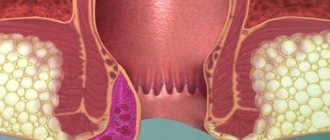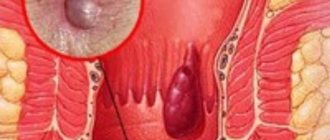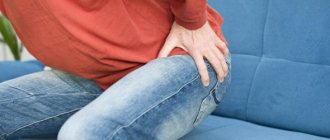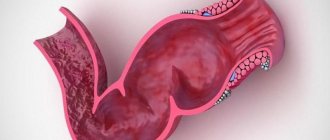Main symptoms:
- Insomnia
- Painful periods
- Chest pain
- Abdominal pain
- Fast fatiguability
- Haemorrhoids
- Headache
- Constipation
- Unpleasant sensations when urinating
- Dyspnea
- Increased gas formation
- Psycho-emotional instability
- Irritability
- Vomiting without relief
- Decreased performance
- Nausea
- Deterioration of general condition
- Cardiopalmus
- Feeling broken
Transversoptosis is a change in the anatomically prescribed position of the large intestine. As the pathology progresses, the transverse colon prolapses: on x-rays it will have the shape of the letter “V”.
- Etiology
- Symptoms
- Diagnostics
- Treatment
- Possible complications
- Prevention and prognosis
Anyone can suffer from the disease, regardless of age and gender. There are a number of both pathological and completely harmless predisposing factors.
The main manifestation of the clinical picture is increased gas production. Against the background of this symptom, other signs develop: pain of varying severity in the abdominal area, periodic nausea leading to vomiting, and other manifestations of deterioration in well-being.
Prolapse of the transverse colon can only be detected using instrumental diagnostic procedures. Laboratory tests and primary diagnostic measures are only of an auxiliary nature.
Treatment begins with attempts to conservatively get rid of the problem by taking medications, following a gentle diet and performing exercise therapy. If there is no positive effect, surgical intervention is considered.
General information and classification
Let's take a closer look at what intestinal colonoptosis is.
This pathology is manifested by the descent of its thick section onto other abdominal organs. As the disease progresses, not only the digestive, but also the reproductive and urinary systems suffer. Self-diagnosis of this condition is difficult due to the blurred clinical picture, which may indicate other diseases of the gastrointestinal tract. Therefore, for timely detection of colonoptosis, it is necessary to contact a medical institution. The classification of pathology implies its division depending on the involvement of one or another part of the intestine in the process:
- left-sided colonoptosis - prolapse of the left part of the transverse colon;
- right-sided colonoptosis - prolapse of the right side of the colon;
- total colonoptosis - prolapse of the entire transverse colon.
In addition, in addition to the usual prolapse, transversoptosis is distinguished - sagging of the organ in the shape of the letter V.
Complications
The first complication that the patient encounters is anemia. This condition develops against the background of frequent bleeding and spotting from the affected area of the intestine. Anemia leads to weakness and increased fatigue.
When the tumor reaches a large size, intestinal obstruction occurs. This process requires immediate surgical intervention. However, the most dangerous consequence of intestinal blastoma is metastasis.
The disease rapidly progresses, due to which the neoplasm spreads to neighboring organs that are essential for the body. Sometimes the affected cells travel through the blood or lymph to distant systems, causing new blastomas there.
Causes
Colonoptosis can be either congenital - due to abnormalities in the development of the intestine at the prenatal stage, or acquired - due to the impact on the body of factors predisposing to this disease.
The main processes leading to intestinal prolapse are:
- flaccidity of the abdominal muscles;
- prolapse of the diaphragmatic muscles;
- weakening of the intestinal ligaments.
The above pathological processes provoke the following unfavorable factors:
- errors in the diet - consumption of fatty, fried foods;
- rapid weight loss (due to a strict diet or serious illness);
- being overweight or obese;
- previous laparotomy operations;
- mechanical injuries of the abdominal organs;
- excessive physical activity;
- hormonal imbalances;
- multiple births in women.
There is a high risk of developing colonoptosis in women with rapid labor. Such a pathology can lead to disruption of the integrity of the musculo-ligamentous apparatus of the intestine, and, as a consequence, prolapse of this organ.
Symptoms
The disease does not have a characteristic clinical picture, which makes its diagnosis much more difficult. Moreover, it may not show any symptoms for a long time.
The main symptoms of colonoptosis are digestive disorders such as constipation and flatulence. Such manifestations develop due to difficulty in the movement of feces through the pathological part of the intestine, stagnation of which leads to the occurrence of fermentation and putrefaction processes, which causes the formation of gases.
Additional symptoms of prolapse include:
- pain in the abdominal area is initially aching, and as the disease progresses, it becomes intense;
- heaviness in the stomach, loss of appetite;
- feeling of fullness of the stomach due to its compression;
- manifestations of dyspepsia - belching, nausea, vomiting;
- a feeling of discomfort in the abdomen when standing, which goes away after the person lies down;
- the appearance of signs of intoxication - weakness, lethargy, decreased performance, headaches; such symptoms arise due to toxins entering the human body from stagnant feces;
- men may experience dysuric disorders, and women may experience painful menstruation and cycle disorders.
As the pathological process progresses and the colon descends into the small pelvis, complications such as hemorrhoids, anal fissures, rectal prolapse, and inflammation of the urinary system develop.
Intestinal transversoptosis
The general name of the disease, which is associated with the descent of the internal organs of the peritoneum, is visceroptosis. Intestinal transversoptosis is one of the varieties of this pathology. During it, the transverse colon changes its normal position. From its usual transverse position, it begins to bend into a V-shape.
This pathology occurs due to decreased muscle tone and a strong increase in pressure inside the peritoneum and sternum. Kinking of the intestine may occur near the liver and spleen. The pathology is quite common and is named after the English anatomist - Payr's disease.
Statistics show that older people are more often affected by this disease. Also in this age group the pathology is more severe. People who frequently lift heavy objects are also at risk of acquiring this disease.
Content
Symptoms
Transversoptosis begins to appear with the following symptoms:
- Minor pain. Manifest as pressure on the abdomen. They usually occur in the middle and lower parts;
- Nausea and vomiting appear periodically;
- There is a headache, frequent irritability;
- Constipation, which appears very often and is severe.
The heart rate may also increase, and there will be pain in the heart and between the shoulder blades. The pain becomes stronger if you eat a lot of food or when exposed to strong physical exertion. When a person takes a horizontal position, the pain begins to subside. Older people experience longer lasting and more excruciating pain.
Intestinal transversoptosis does not have characteristic clinical symptoms. Many other diseases fit the criteria described above. Pathology does not have a symptom that would definitely indicate a disease.
It is very important that the diagnosis is established correctly. After all, here the disorder is anatomical and not functional in nature, as, for example, with intestinal irritation. Only establishing a correct diagnosis will allow you to get rid of the disease, because the pathology cannot go away on its own.
First, the doctor must perform deep palpation of the abdomen. After this, instrumental and laboratory tests are prescribed. First of all, an ultrasound examination is performed. During it, pathologies such as cholecystitis and pancreatitis are excluded.
Most diseases associated with the gastrointestinal tract have pain syndromes. In order not to make a mistake in making a diagnosis, an X-ray analysis is required. During it, the shape and location of the colon is examined. To carry out such an examination, a barium suspension is used. But such examination is very expensive.
Some medical institutions prescribe the radioisotope method. It allows you to identify the level of impairment of intestinal motor activity in children.
Treatment
Once doctors have made an accurate diagnosis, comprehensive treatment begins. It includes the following therapy:
- There is a complete adjustment of the diet. It includes foods that are high in calories, but which are easily digested by the body and contain a small amount of waste. You also need lactic acid food, which contains a lot of organic acids. It is necessary to enhance the secretion and peristaltic activity of the mucous membrane. Fruits and sweet foods, especially honey and sugar, are good at thinning the contents of the intestines and activating peristalsis. Be sure to drink plenty of fluids.
- Gymnastic exercises are prescribed. They play the role of a general strengthening agent. As you know, pathology occurs due to insufficiently developed abdominal muscles. Therefore, physical therapy is simply necessary. Massage on the abdomen, paraffin application to painful areas of the body and electrophoresis using novocaine help reduce pain.
- For prolonged constipation, it is recommended to drink juices from vegetables and fruits, and herbal infusions also help well. You need to consume a large amount of these drinks every day.
- The use of traditional medicine is allowed, but only as an auxiliary measure.
If conservative therapy fails to cure the disease, then surgical intervention is resorted to. The operation may be prescribed at the very beginning of the disease, if there is:
- Chronic intoxication;
- Attacks of obstruction in the large intestine;
- Constant pain syndrome.
Surgery is necessary when pain is accompanied by bloating. Previously, surgical treatment began with resection of the middle part of the transverse colon, which was then dragged under the gastrocolic ligament. In this case, the free end was secured to the posterior wall of the abdominal cavity, positioning it across. But such surgical intervention had an increased risk of dangerous consequences.
After this, Pyre proposed his own method of operation. The transverse colon is sutured directly to the stomach using different sutures. This operating method is only suitable for adults. This method is not recommended for children. After all, it disrupts the normal ratio of organs, since the child’s body is constantly growing.
Children most often undergo segmental coloplication, which has a transverse direction. This procedure involves reducing the length of the intestine.
Save your body from parasites! Pain and bloating in the abdomen may be due to PARASITES. A parasitologist recommends consuming once a day... — Read more »
Only a doctor who has received the results of all necessary tests should prescribe treatment. At the initial stage of the disease, treatment at home is allowed. This disease cannot be started, otherwise the consequences will be unfavorable. Treatment of a complicated degree of the disease is necessary only in a hospital. Minor intoxication may occur, which will require urgent surgical intervention.
After the operation, the patient must monitor his diet. A proper diet is an excellent prevention against various gastrointestinal diseases.
kiwka.ru
Diagnostics
To identify colonoptosis, the patient is prescribed a diagnostic complex, which consists of clinical and additional research methods.
The attending physician carries out the following clinical diagnostic methods:
- collection of complaints - the most disturbing symptoms are determined, as well as signs indicating intestinal prolapse;
- anamnesis collection - information is collected about the patient’s diet and lifestyle, the duration of clinical symptoms; possible causes and predisposing factors of the disease are identified;
- physical examination of the patient - a general examination of the patient is carried out, during which sagging of the abdominal wall is revealed (even with a normosthenic body type);
- palpation of the abdomen - during this clinical study, the specialist identifies the following signs of coloptosis:
- pulsation of the abdominal aorta in the supine position;
- when the abdominal wall is stretched, the pain syndrome weakens;
- displacement of the pylorus of the stomach.
After clinical diagnosis, the doctor prescribes additional tests for the patient.
Additional diagnostic measures include laboratory and instrumental studies:
- clinical blood test - signs of possible inflammation and anemia are diagnosed (if there are complications);
- general urinalysis - possible inflammatory processes of the urinary system are identified;
- irrigoscopy - X-ray examination of the intestines with the introduction of contrast - the most informative diagnostic method; allows you to determine the degree of descent of the organ;
- colonoscopy is an invasive diagnostic method that allows you to evaluate the mucous membrane of an organ, determine the stenosis of its lumen, and also take a biopsy for further research;
- histological examination of a biopsy sample is a laboratory method that is carried out to determine the cellular structure of the affected part of the intestine (diagnosis of oncology).
After studying the research results, the attending physician prescribes appropriate therapy.
Treatment
Treatment of colonoptosis is aimed at strengthening the musculo-ligamentous apparatus of the intestine and eliminating unpleasant symptoms. Treatment of the disease involves adjusting the diet and lifestyle, doing physical therapy, taking medications and performing surgery.
Non-drug therapy for colonoptosis is the basis of its treatment. It includes the following methods:
- lifestyle changes;
- specialized diet;
- gymnastics classes;
- wearing a bandage;
- use of folk remedies.
In order to activate intestinal motility and strengthen the ligaments that support it, it is necessary to lead an active lifestyle. It involves daily walks in the fresh air and adequate physical activity. Such measures prevent constipation and improve the general condition of the patient.
The diet for colonoptosis is aimed at preventing constipation and flatulence, as well as accelerating intestinal motility.
The diet includes the following nutritional recommendations:
- inclusion in the diet of products containing coarse plant fibers - bran, unground cereals, raw fruits and vegetables;
- drinking enough water – up to two liters per day;
- limiting foods that provoke flatulence - baked goods, legumes, fresh cabbage, grapes;
- restriction in the diet of foods that slow down intestinal motility - mucous soups and cereals, crushed food;
- The consumption of fatty, spicy foods, marinades, smoked meats, and spices is excluded.
To determine the most suitable diet, it is recommended to seek the help of a doctor. He will create a diet taking into account the course of the disease and the individual characteristics of the body.
How is colonoptosis treated?
Treatment of intestinal colonoptosis can be carried out conservatively and surgically. The main goal of therapy is to restore intestinal motility. If the disease was detected at an early stage and treatment began immediately, it is possible to use conservative methods: diet therapy, medication, herbal medicine, and therapeutic exercises. Acupuncture and acupressure may be effective. Popular folk recipes for getting rid of illness are based on taking herbal decoctions that remove toxins from the body, have a calming effect, and normalize intestinal function.
The doctor may also recommend that the patient wear a bandage for colonoptosis. It allows you to fix the intestine in the correct position and restore its tone. However, you should not use a bandage without consulting a doctor.
General rules
Colon prolapse (colonoptosis) is a pathology characterized by displacement of the loops of the large/small intestine towards the pelvis. The main reasons are inflammatory processes and decreased tone of the muscle structure of the intestine, weakness of the muscles of the anterior abdominal wall, heavy physical activity, pathology of the intestinal ligamentous apparatus, surgery on the abdominal organs, pathology of the spinal column, difficult pregnancy, and rapid weight loss. Symptoms of this pathology are not specific and manifest themselves mainly in the form of flatulence, chronic constipation, a feeling of heaviness in the lower abdomen, general weakness, and, less often, nausea and not profuse vomiting.
Prolapse of the intestine can be confirmed by a plain contrast radiograph of the abdominal cavity, performed over time. Treatment of the disease is complex and includes wearing a special bandage, gymnastic exercises to strengthen the abdominal muscles, and correction of the diet.
The diet for colonoptosis is aimed primarily at normalizing stool (preventing constipation and bloating), which is achieved by including in the diet foods that enhance intestinal motility. Such products include:
- Containing a large amount of dietary fiber - wholemeal bread, cereals (buckwheat, millet, barley, oatmeal, pearl barley), bran, raw vegetables, legumes, nuts, dried fruits.
- With a high content of organic acids - pickled/pickled vegetables, fermented milk drinks, sour fruits/juices, fruit drinks.
- Meat with a lot of connective tissue.
- Rich in sugars (cane sugar, milk sugar, jams, syrups, syrups, honey, dextrose, sweet dishes).
- Containing salt - salted vegetables/fish, canned snack foods.
- Fats (sour cream/cream), consumed in large quantities on an empty stomach, egg yolks.
- Carbonated drinks.
- Cold dishes (jellied dishes, okroshka, beetroot soup, cold drinks, ice cream) consumed on an empty stomach, since the difference in body temperature and the product is the leading factor that has a stimulating effect on the intestines.
It is mandatory to include in the diet such products as kumiss/kvass, which have a pronounced effect due to the content of carbon dioxide/organic acids, sauerkraut (a source of fiber/organic acids), bran/sea kale, which are prone to swelling with the attraction of fluid into the intestines, which helps soften the intestinal contents, as well as foods with a pronounced laxative effect (prunes, beets, plums, fresh kefir, vegetable juices).
At the same time, foods that slow down peristalsis and, accordingly, bowel emptying should be excluded from the diet: mucous soups, hot dishes, black coffee, cocoa, chocolate, strong tea, dogwood, lingonberries, jelly, pears, blueberries, pomegranate, pasta, red wine , as well as fried foods that enhance fermentation/rotting processes.
When choosing a diet, the presence of concomitant gastrointestinal diseases should be taken into account. The diet for colonoptosis requires the consumption of a sufficient amount of free fluid - at least 2 l / day due to the fact that with a lack of fluid in the sigmoid colon, water is absorbed from the feces and they harden, thereby complicating the act of defecation. Food is prepared mainly by boiling/baking and served uncut. Vegetables in the diet should be present mainly raw and partially boiled.
Transversoptosis of the intestine (large intestine)
Published: November 12, 2020 at 10:38 am
Prolapse of the internal organs of the peritoneum is commonly called visceroptosis, and is characterized by decreased muscle tone and increased pressure inside the peritoneum and sternum. Usually, prolapse of not all organs is observed, but of individual organs, among which the most common is sagging of the transverse colon - transversoptosis.
Transversoptosis of the intestine leads to a change in the normal position of the transverse colon, which, instead of the transverse direction, bends, taking on the appearance of the Latin letter V. Hanging of the organ with kinks in the area of the hepatic and splenic angles is called Payr's disease. At the same time, sharp excesses and impaired motor skills lead to prolonged and severe constipation and the development of inflammatory processes.
Symptoms of transversoptosis
The primary symptoms of transversoptosis are:
- pain accompanied by a feeling of pressure in the abdomen;
- constipation;
- manifestations of nausea and vomiting;
- headaches, attacks of irritability.
In addition, with transversoptosis, patients experience symptoms: rapid heartbeat, burning pain in the heart area, pain between the shoulder blades. The pain intensifies after eating a large amount of food or with significant physical activity. Adopting a horizontal position reduces the intensity of pain. In older patients, pain is more prolonged and painful.
Pain syndrome is characteristic of most gastrointestinal diseases. Therefore, in order to eliminate errors in the correct diagnosis of intestinal transversoptosis, radiographic analysis is performed using the irriography method, paying attention to the shape and position of the large intestine. Barium suspension is used as a contrast agent. By massaging the abdomen with your fingers, the displacement of the transverse colon is determined. In some medical institutions, to determine the level of impairment of intestinal motor function in children, along with fluoroscopy, a radioisotope method is used.
After establishing an accurate diagnosis, complex therapy is prescribed. First of all, the diet is adjusted with a predominance of high-calorie and easily digestible food that does not contain a large amount of slag waste. To enhance secretion and peristaltic activity of the mucous membrane, lactic acid products with a high content of organic acids are introduced into the diet. Honey, sugar, sweet foods and fruits help thin the intestinal contents and activate peristalsis.
Gymnastics plays an important role in the treatment of transversoptosis as a general strengthening agent. To reduce pain, paraffin applications on the abdomen, electrophoresis with novocaine, and abdominal massage are prescribed. For transversoptosis, accompanied by prolonged and severe constipation, vegetable and fruit juices and decoctions of medicinal herbs are prescribed. For daily consumption, these drinks must be in very large quantities. Folk remedies can be used as auxiliaries to enhance peristalsis and dilute stool during constipation.
If there is no effect from conservative therapy, surgery is prescribed. In addition, the need for surgery is determined if the following indicators are present:
- chronic intoxication;
- attacks of colon obstruction;
- inability to relieve pain.
How to treat transversoptosis should only be determined by a doctor based on an analysis of the clinic and research results. The development of active surgical tactics for transversoptosis, especially with pronounced pain syndrome, accompanied by bloating and the threat of acute intestinal obstruction, is taken by an experienced surgeon. Previously, resection of the middle part of the transverse colon was used for surgical treatment of the disease. Then it was moved under the gastrocolic ligament and with subsequent strengthening of the free end in the transverse direction to the posterior wall of the abdominal cavity. However, the need for resection of the colon with anastomosis significantly increased the dangerous consequences of the operation.
More popular is the operation proposed by Pyre, in which the transverse colon is sutured directly to the stomach using separate sutures. However, if it is necessary to perform surgery for children with transversoptosis, this method is not accepted due to the violation of the normal ratio of organs in a growing child’s body. Therefore, in this case, segmental coloplication in the transverse direction is used to reduce the length of the intestine. Hemming occurs normally as the child grows. In any case, with transversoptosis of the colon, there is no alternative to treatment in one form or another.
zhkt.guru
Authorized Products
The diet for colonoptosis includes the following in the diet:
- Soups with weak/low-fat meat and fish broth with the addition of cereals and vegetables (cabbage soup, hlodniki, borscht, beetroot soup).
- Various vegetables (lettuce, cucumbers, beets, zucchini, carrots, tomatoes, pumpkin, green peas, cauliflower) raw, boiled and stewed. Vinaigrettes with vegetable oil, seaweed salads, and vegetable caviar are especially useful.
- Low-fat varieties of red meat, turkey, rabbit, chicken, which are cooked boiled or baked. For severe constipation and flatulence, it is recommended to replace red meat with fish.
- Cereals (barley, wheat, buckwheat, millet, pearl barley) from which crumbly porridges and casseroles are prepared.
- Fermented milk products (kumys, kefir, yogurt, acidophilus yogurt), matsoni, fresh cottage cheese, which contain organic acids in large quantities, and are therefore useful for constipation.
- Chicken eggs up to 2 pieces per day in the form of steam omelettes, soft-boiled, omelettes with vegetables.
- Fresh sweet types of fruits/berries and dried fruits (figs, dried apricots, prunes, apricots).
- Sweets include marshmallows, marmalade, honey.
- Wheat bread made from 2nd grade flour baked yesterday, as well as grain and rye bread if well tolerated, dry biscuit.
- Carbonated fruit and berry drinks, weak tea, sparkling mineral waters, rose hip infusion, coffee substitutes, bran decoction, juices (tomato, beet, plum, apricot, carrot).
| Proteins, g | Fats, g | Carbohydrates, g | Calories, kcal | |
| zucchini | 0,6 | 0,3 | 4,6 | 24 |
| cabbage | 1,8 | 0,1 | 4,7 | 27 |
| sauerkraut | 1,8 | 0,1 | 4,4 | 19 |
| cauliflower | 2,5 | 0,3 | 5,4 | 30 |
| carrot | 1,3 | 0,1 | 6,9 | 32 |
| pickles | 0,8 | 0,1 | 1,7 | 11 |
| rhubarb | 0,7 | 0,1 | 2,5 | 13 |
| beet | 1,5 | 0,1 | 8,8 | 40 |
| tomatoes | 0,6 | 0,2 | 4,2 | 20 |
| pumpkin | 1,3 | 0,3 | 7,7 | 28 |
| apricots | 0,9 | 0,1 | 10,8 | 41 |
| watermelon | 0,6 | 0,1 | 5,8 | 25 |
| bananas | 1,5 | 0,2 | 21,8 | 95 |
| melon | 0,6 | 0,3 | 7,4 | 33 |
| nectarine | 0,9 | 0,2 | 11,8 | 48 |
| peaches | 0,9 | 0,1 | 11,3 | 46 |
| plums | 0,8 | 0,3 | 9,6 | 42 |
| apples | 0,4 | 0,4 | 9,8 | 47 |
| dried figs | 3,1 | 0,8 | 57,9 | 257 |
| dried apricots | 5,2 | 0,3 | 51,0 | 215 |
| dried apricots | 5,0 | 0,4 | 50,6 | 213 |
| prunes | 2,3 | 0,7 | 57,5 | 231 |
| buckwheat (kernel) | 12,6 | 3,3 | 62,1 | 313 |
| oat groats | 12,3 | 6,1 | 59,5 | 342 |
| corn grits | 8,3 | 1,2 | 75,0 | 337 |
| pearl barley | 9,3 | 1,1 | 73,7 | 320 |
| wheat bran | 15,1 | 3,8 | 53,6 | 296 |
| millet cereal | 11,5 | 3,3 | 69,3 | 348 |
| barley grits | 10,4 | 1,3 | 66,3 | 324 |
| oatmeal bread | 10,1 | 5,4 | 49,0 | 289 |
| Rye bread | 6,6 | 1,2 | 34,2 | 165 |
| bran bread | 7,5 | 1,3 | 45,2 | 227 |
| doctor's bread | 8,2 | 2,6 | 46,3 | 242 |
| whole grain bread | 10,1 | 2,3 | 57,1 | 295 |
| jam | 0,3 | 0,2 | 63,0 | 263 |
| jelly | 2,7 | 0,0 | 17,9 | 79 |
| marshmallows | 0,8 | 0,0 | 78,5 | 304 |
| milk candies | 2,7 | 4,3 | 82,3 | 364 |
| fondant candies | 2,2 | 4,6 | 83,6 | 369 |
| fruit and berry marmalade | 0,4 | 0,0 | 76,6 | 293 |
| paste | 0,5 | 0,0 | 80,8 | 310 |
| oatmeal cookies | 6,5 | 14,4 | 71,8 | 437 |
| honey | 0,8 | 0,0 | 81,5 | 329 |
| sugar | 0,0 | 0,0 | 99,7 | 398 |
| kefir | 3,4 | 2,0 | 4,7 | 51 |
| sour cream | 2,8 | 20,0 | 3,2 | 206 |
| curdled milk | 2,9 | 2,5 | 4,1 | 53 |
| kumiss | 3,0 | 0,1 | 6,3 | 41 |
| acidophilus | 2,8 | 3,2 | 3,8 | 57 |
| yogurt | 4,3 | 2,0 | 6,2 | 60 |
| cottage cheese | 17,2 | 5,0 | 1,8 | 121 |
| beef | 18,9 | 19,4 | 0,0 | 187 |
| beef liver | 17,4 | 3,1 | 0,0 | 98 |
| beef tongue | 13,6 | 12,1 | 0,0 | 163 |
| veal | 19,7 | 1,2 | 0,0 | 90 |
| rabbit | 21,0 | 8,0 | 0,0 | 156 |
| chicken | 16,0 | 14,0 | 0,0 | 190 |
| turkey | 19,2 | 0,7 | 0,0 | 84 |
| chicken eggs | 12,7 | 10,9 | 0,7 | 157 |
| herring | 16,3 | 10,7 | — | 161 |
| butter | 0,5 | 82,5 | 0,8 | 748 |
| corn oil | 0,0 | 99,9 | 0,0 | 899 |
| olive oil | 0,0 | 99,8 | 0,0 | 898 |
| sunflower oil | 0,0 | 99,9 | 0,0 | 899 |
| mineral water | 0,0 | 0,0 | 0,0 | — |
| instant chicory | 0,1 | 0,0 | 2,8 | 11 |
| black tea with milk and sugar | 0,7 | 0,8 | 8,2 | 43 |
| apricot juice | 0,9 | 0,1 | 9,0 | 38 |
| carrot juice | 1,1 | 0,1 | 6,4 | 28 |
| plum juice | 0,8 | 0,0 | 9,6 | 39 |
| tomato juice | 1,1 | 0,2 | 3,8 | 21 |
| pumpkin juice | 0,0 | 0,0 | 9,0 | 38 |
| rose hip juice | 0,1 | 0,0 | 17,6 | 70 |
| * data is per 100 g of product |
Fully or partially limited products
The diet for colonoptosis involves exclusion from the diet:
- Dishes and foods that move slowly through the intestines, dishes with a viscous consistency - pureed porridge, slimy soups, mashed potatoes, jelly.
- Dishes that contain tannins - dogwood jelly, quince, blueberry, pear, bird cherry, cocoa, strong tea/coffee.
- Chocolate and cream products, baked goods made from yeast/puff pastry, bread made from premium flour.
- Foods that cause constipation - potatoes, rice, semolina, vermicelli, noodles, sago, and for flatulence - legumes, cabbage, black bread, bananas, grapes, raisins.
- Difficult to digest foods - fatty red meat and fish, duck, goose, smoked meats, canned food, hard-boiled eggs.
- Spicy foods that irritate the gastrointestinal mucosa (spices, seasonings, sauces).
Colonoptosis is prolapse of the colon. The colon is attached to the posterior wall of the abdominal cavity by means of ligaments, which, when weakened or partially torn, sag. Violation of normal spatial orientation changes the functioning of the intestine, its motility and causes symptoms of partial obstruction and fecal intoxication.
Therapy
Treatment is usually carried out using a conservative method. Therapy uses exercise therapy, massage, and a special diet is prescribed. In some cases, the doctor recommends using a bandage. As practice shows, surgical intervention is prescribed in two situations. First of all, surgery is recommended if all conservative methods have been tried and have not brought results, and the signs of the disease are intensifying. If we talk about the second situation, then we need to mention first what the threat of intestinal prolapse is. This pathology can provoke a disruption of the blood supply to the peritoneal organs, complete or partial obstruction. In such difficult cases, surgical interventions are performed. Meanwhile, doctors, even after a successful operation, do not guarantee that the problems will completely disappear and there will be no relapse (recurrence). Without the participation of the patient himself and his efforts, it is almost impossible to achieve a lasting positive effect.
Causes
- multiple pregnancy, when the abdominal organs are compressed and displaced by an overly enlarged uterus;
- sudden weight loss, when the size of the abdominal omentum quickly decreases and the intestines lose their usual support;
- heavy physical activity and especially repeated lifting of weights - a sharp rise in intra-abdominal pressure contributes to prolapse;
- scoliosis and other curvatures of the spine, in which the intestines are deprived of the possibility of normal attachment;
- abnormalities in the structure of the colon, in particular weakness of the ligamentous apparatus;
- chronic stress, which contributes to constant intestinal spasms;
- prolapse of other organs located in the abdominal cavity, especially the stomach;
- disturbances of hormonal homeostasis, under the influence of which tissue elasticity changes;
- surgical removal of large tumors, after which free space is formed in the abdominal cavity;
- old age, when the density of all tissues decreases;
- severe obesity.
One person may have several causes at the same time.
Symptoms
Manifestations of colonoptosis can be very roughly divided into local and general.
These are all the symptoms associated with a violation of the movement of the food bolus:
- bloating caused by interruption of food passage;
- flatulence or excessive gas production;
- constipation that cannot be treated with conventional remedies;
- abdominal pain, somewhat relieved in a horizontal position;
- urinary disorders and even inflammation of the urinary organs due to compression.
Bloating and constipation impair digestion of food, and patients may lose weight due to refusal to eat. Concomitant inflammation of the digestive canal is common.
These are signs of fecal intoxication due to untimely removal of decay products, as well as disturbances in other organs:
- nausea;
- vomit;
- headache;
- weakness;
- decreased appetite and mood;
- phlebeurysm;
- haemorrhoids;
- menstrual irregularities in women and prostatitis in men.
Diagnostics
There are two main diagnostic methods:
- Irrigoscopy is an X-ray examination of the colon, into which a contrast agent has previously been injected. This method is considered the most informative, since structural features, areas of expansion and contraction, and the true position of the colon in the abdominal cavity are revealed. The contrast mass allows you to evaluate the speed and obstacles as the food bolus moves, the duration of delays and other features.
- Colonoscopy is an examination of the colon using endoscopic equipment. It is possible to record on digital media and store in an archive for later comparison. The doctor evaluates the characteristics of the mucous membrane, the presence of ulcers and other defects; if necessary, material can be taken from the suspicious area for a biopsy. It is possible to inject the medicine directly into the intestine.
The remaining examination methods - laboratory and instrumental - are of an auxiliary nature. Sigmoidoscopy is sometimes used, but this is at the discretion of the attending physician. Additionally, ultrasound of the abdominal organs and computed tomography can be used if the clinical situation requires it.
Treatment
Conservative and surgical methods are used, their combination is determined by the doctor.
The main task is to restore motor skills and normalize the movement of food, eliminate bloating and constipation. For this purpose, diet, medications, bandages, and physical therapy are used.
Products that enhance peristalsis are used:
- containing a lot of fiber or dietary fiber - bran bread, raw vegetables and fruits, legumes, nuts, coarse cereals (barley, barley);
- containing organic acids - lactic acid, naturally pickled vegetables, sour juices and fruit drinks;
- sweet dishes;
- meat of old animals containing a large amount of connective tissue;
- carbonated drinks;
- dishes served cold - okroshka, beetroot soup, aspic, ice cream - which stimulate peristalsis due to temperature.
Food should be large in volume, but low in calories. It is useful to eat dishes of contrasting temperatures. Losing body weight and regularly filling the intestines with rough foods helps eliminate constipation.
Laxatives are used only as prescribed by a doctor for a short course. They cannot be used often, as addiction to them quickly develops. Anti-inflammatory agents, enveloping agents, and digestive enzymes may sometimes be used.
This is a medical product whose purpose is to support the abdominal organs. The bandage is an elastic belt, which is selected individually according to size. You need to put it on in bed before getting up, wear it throughout the day, and take it off before going to bed while lying down.
The bandage is most effective for stretching the muscles and white line of the abdomen, which happens after pregnancy and sudden weight loss.
Physical exercises are aimed at strengthening the anterior abdominal wall. The movements are something like this:
Use decoctions and infusions to reduce flatulence and constipation. The following are used:
- infusion of yarrow and wormwood (pour 2 tablespoons of the mixture with a glass of boiling water, keep in a water bath for 5 minutes, strain, filter, dilute with a glass of boiled water, drink 1-2 tablespoons before meals three times a day);
- dill water - mix cumin, dill and fennel (seeds) in equal parts, pour 1 tablespoon of the mixture with a glass of boiling water, leave for 2 hours, drink 1 sip during the day, drink the entire volume per day).
Used in extreme cases, the operation is abdominal and very complex. Its essence is to suture intestinal loops to weakened ligaments with a non-absorbable thread. The complexity of the operation is that there is no guarantee of a return to health - adhesions may form at the site of the threads, and the ligaments may weaken even more.
Due to the large number of complications, surgical treatment is used less and less.
Physiotherapy
Toning the muscle structure of the abdominal area is the best way to treat prolapse. Exercise will not only help strengthen the muscles that support the organ, but can also raise the diaphragm. Under such conditions, the gastrointestinal tract is able to function normally.
Gymnastics to treat the disease is performed in a supine and standing position. The load is provided by raising the pelvis and moving the lower limbs.
Therapeutic complex of strengthening exercises:
- You need to lie on your back. A medium-heavy book is placed in the diaphragm area. Hands at your sides. Legs lie straight. This is followed by calm, even breathing. When you inhale, you need to inflate your stomach, and when you exhale, relax. Perform actions within 3-8 minutes.
- Lying on your back, you need to bend both legs and pull them towards your stomach, and then straighten them and take a straight starting position of the body. Perform 2-3 sets of 20 times.
- In the same lying position, you need to bend your legs shoulder-width apart, leaning on your feet to raise and lower your pelvis. You can help yourself with additional emphasis on your elbows. Movements are performed until you feel slightly tired.
- In a relaxed lying position, with your legs straight, you will need to alternately raise and lower your lower limbs. Hold each leg up for 5 seconds. Additionally, you can perform the “scissors” exercise.
- Lie on your back and do the bicycle exercise. To do this, you will need to imitate the movements of your legs, as when rotating the pedals (if you feel very unwell, you can refuse the exercise). Perform until your legs become tired.
- Take a standing position. Walk with your hips raised high, while your legs bend at the knees. Continue exercising for 1-2 minutes.
- Stand against the wall and spread your legs slightly. Bend your arms at the elbows and alternately rotate your upper body. Hold the position for 10 seconds with each turn. Perform movements 10 times in each direction.
- Stand straight. Legs straight, arms along the body. On the count of one, raise your straight upper limbs up and take your right leg back (put it on your toes). On the count of two, take the starting position. Repeat the same with the other leg. You need to do alternating movements 10-20 times on each leg.
The duration and number of approaches are adjusted by the attending physician at his own discretion. He may also add some exercises on an individual basis. The main thing in physical therapy is regularity.
Constant moderate exercise can quickly bring the patient back to normal, especially if treatment occurs in conjunction with diet and wearing a bandage.











